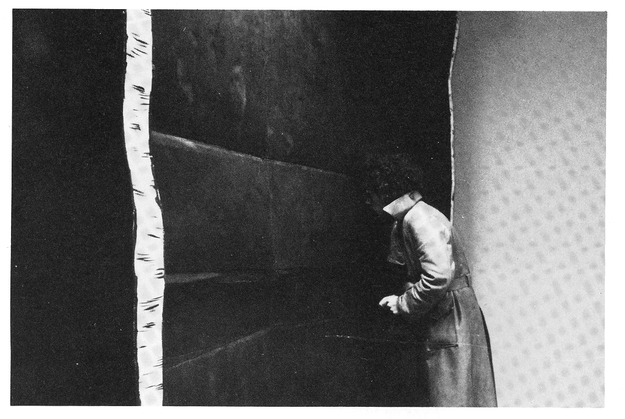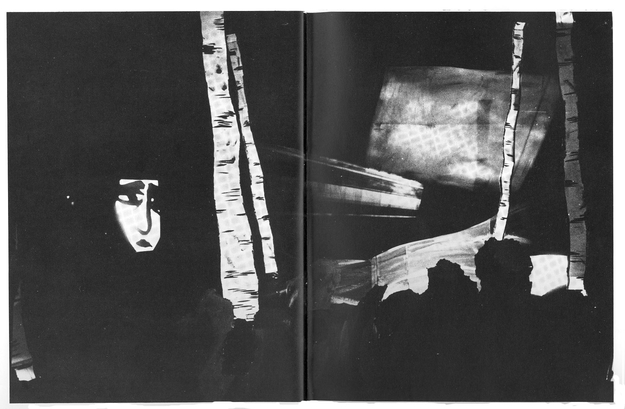GALLERY CIRELLI is a small and slightly subterranean space which during Seelenwald was all but filled with a large black box, a kind of a giant peep-show. Peering through a hole cut at eye-level, the viewer is confronted with a tableau of decors and video, plus super-8 films projected at oblique angles on the far wall. These film-loops showed journeys: a train constantly passing, the monotony of traffic signs and highway lights shot from a moving car. These repetitive, everyday images were contrasted with a jungle of bushes and tree. trunks in the foreground, crudely but out of corrugated cardboard and painted with broad gestural strokes.
Magic
While the film-loops presented the fact of modern travel in a tawdry man-made world of broad daylight, these decors were dimly lit, the trunks mysteriously floating in midair. The sensation was much like driving through the country at night and realizing that no matter how high-speed and technological one's immediate surroundings may be, the world outside is unknowable, spooky and all too close for comfort. Here, one would have a hard time remembering that ghosts, the supernatural are mere superstition (they say). The spirits in Seelenwald (Ghost Wood) appear on two monitors, placed to the left and the right. They are recordings of a painted mask which moves in and out of frame to the sound of a few notes which break up into harmonics. This mask is particularly affecting, its face has a troubled, haunted quality. Seelenwald is a clear combination of the magical and the crass, executed by means of sophisticated technology and cardboard boxes thrown out of the local supermarket.
The use of decors seems to have a lot going for it these days. And apart from its conscious application in theater, films and television, there is a wide range of artists in the Netherlands (for some reason) who include decors in their work: from LYDIA SCHOUTEN to KEES DE GROOT, from JAAP DE JONGE to SIXMA and VIJSELAAR to my own tapes with DAVID GARCIA. The stage that is furnished with decors is essentially an inner, cerebral one. The materials needed are easily available (even free), yet their clever manipulation can make computer graphics seem thin and mindless by comparison. Dutch TV satirists VAN KOOTEN and DE BIE exploited this to the full when at the end of each program, they clumsily manhandled 3-D models of their names against a curtain of tacky stars. Decors create irony by placing quotation marks around the 'real': witness the heavenly clouds and cherubs with absurdly flapping wings that form a backdrop for VON STERNBERG's Blue Angel in 1929. It is one of the easiest ways to specify a personal vocabulary of symbols (as LYDIA SCHOUTEN does), to map out an inner landscape (as DAVID GARCIA and I do). But the use of decors has an especially powerful attraction for the artist: it allows you to maintain that gutsy physicality of working with paint and other anal stage materials within what is essentially a push button medium. In video installations, decors produce a fixed image, one you can hold onto like a painting or sculpture, video always remains fleeting, transitory. I imagine that it was these possibilities in particular that appealed to the members of VOORLAND.
Ad hocism
Much of Seelenwald's poignancy comes from the contrast between the temporary and the permanent: the journeys on film like the ghosts on video may come and go but the trees and the bushes remain forever. And these roadside landscapes have been created out of corrugated cardboard, the very garbage you find in every lay-by, littering every picturesque view: the detritus of the consumer society.
But whilst ad hocism is definitely one of video art's more beguiling qualities, I found VOORLAND's depiction of bush and tree trunk somewhat lackluster. In fact, as painters (and here they must be considered as such) they leave something to be desired with the exception of the striking mask-like image on the video. I also had doubts about the tackiness of the peep-show box itself (basically a big cardboard box with painted birch trees on either side). On entering the gallery, 1 already had a reasonably clear idea of the style of work I was about to see which removed some of the anticipation of what was actually to be seen inside the box. A more neutral box would have heightened the sense of tension, literally and metaphorically, between the world within and the world outside. These few reservations aside, I thought that Seelenwald was a successful integration of the magical and the entirely unmagical using both technology and the simplest of means.

